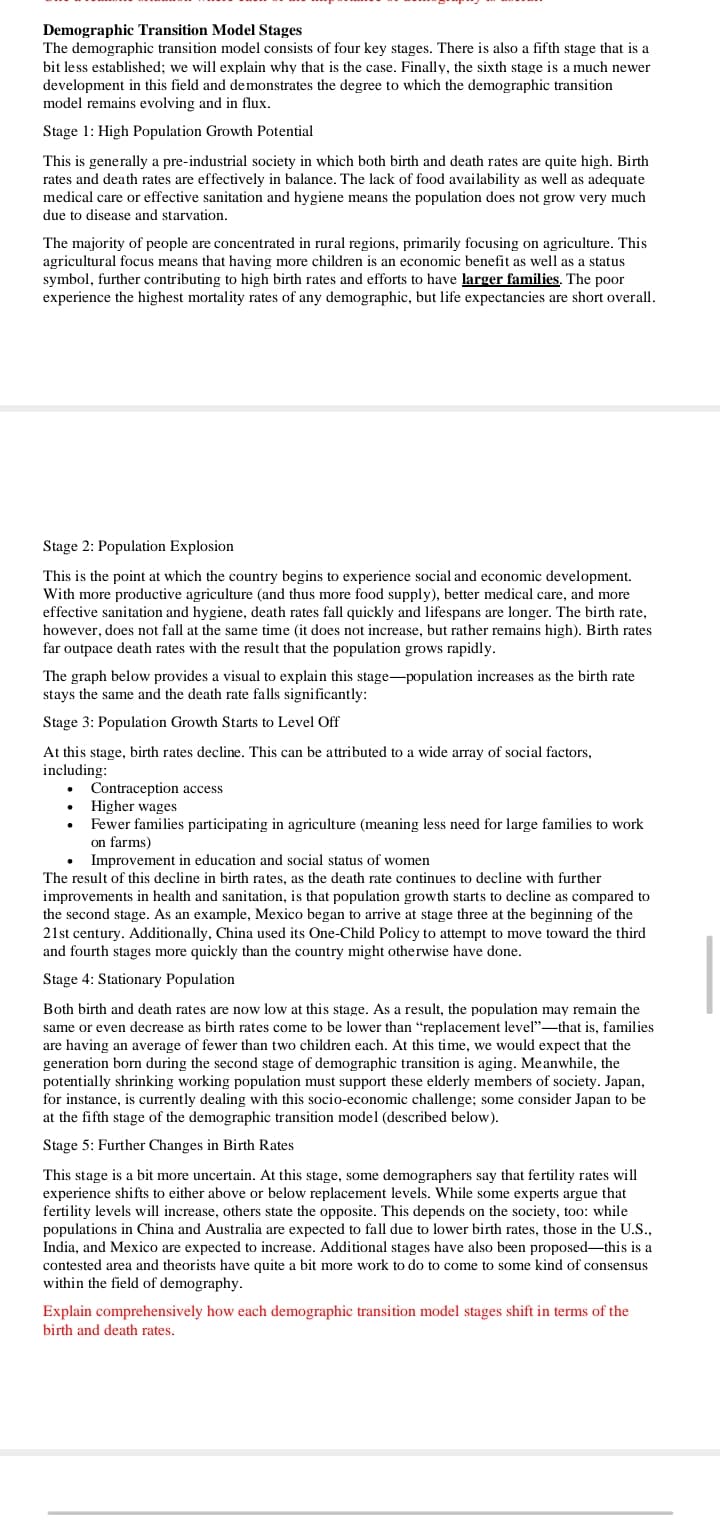Explain comprehensively how each demographic transition model stages shift in terms of the birth and death rates. Stage 1: High Population Growth Potential Stage 2: Population Explosion Stage 3: Population Growth Starts to Level Off Stage 4: Stationary Population
Explain comprehensively how each demographic transition model stages shift in terms of the birth and death rates. Stage 1: High Population Growth Potential Stage 2: Population Explosion Stage 3: Population Growth Starts to Level Off Stage 4: Stationary Population
Chapter1: Making Economics Decisions
Section: Chapter Questions
Problem 1QTC
Related questions
Question
Explain comprehensively how each demographic transition model stages shift in terms of the birth and death rates.
Stage 1: High Population Growth Potential
Stage 2: Population Explosion
Stage 3: Population Growth Starts to Level Off
Stage 4: Stationary Population
Stage 5: Further Changes in Birth Rates

Transcribed Image Text:Demographic Transition Model Stages
The demographic transition model consists of four key stages. There is also a fifth stage that is a
bit less established; we will explain why that is the case. Finally, the sixth stage is a much newer
development in this field and demonstrates the degree to which the demographic transition
model remains evolving and in flux.
Stage 1: High Population Growth Potential
This is generally a pre-industrial society in which both birth and death rates are quite high. Birth
rates and death rates are effectively in balance. The lack of food availability as well as adequate
medical care or effective sanitation and hygiene means the population does not grow very much
due to disease and starvation.
The majority of people are concentrated in rural regions, primarily focusing on agriculture. This
agricultural focus means that having more children is an economic benefit as well as a status
symbol, further contributing to high birth rates and efforts to have larger families. The poor
experience the highest mortality rates of any demographic, but life expectancies are short overall.
Stage 2: Population Explosion
This is the point at which the country begins to experience social and economic development.
With more productive agriculture (and thus more food supply), better medical care, and more
effective sanitation and hygiene, death rates fall quickly and lifespans are longer. The birth rate,
however, does not fall at the same time (it does not increase, but rather remains high). Birth rates
far outpace death rates with the result that the population grows rapidly.
The graph below provides a visual to explain this stage-population increases as the birth rate
stays the same and the death rate falls significantly:
Stage 3: Population Growth Starts to Level Off
At this stage, birth rates decline. This can be attributed to a wide array of social factors,
including:
Contraception access
• Higher wages
Fewer families participating in agriculture (meaning less need for large families to work
on farms)
Improvement in education and social status of women
The result of this decline in birth rates, as the death rate continues to decline with further
improvements in health and sanitation, is that population growth starts to decline as compared to
the second stage. As an example, Mexico began to arrive at stage three at the beginning of the
21st century. Additionally, China used its One-Child Policy to attempt to move toward the third
and fourth stages more quickly than the country might otherwise have done.
Stage 4: Stationary Population
Both birth and death rates are now low at this stage. As a result, the population may remain the
same or even decrease as birth rates come to be lower than "replacement level"-that is, families
are having an average of fewer than two children each. At this time, we would expect that the
generation born during the second stage of demographic transition is aging. Meanwhile, the
potentially shrinking working population must support these elderly members of society. Japan,
for instance, is currently dealing with this socio-economic challenge; some consider Japan to be
at the fifth stage of the demographic transition model (described below).
Stage 5: Further Changes in Birth Rates
This stage is a bit more uncertain. At this stage, some demographers say that fertility rates will
experience shifts to either above or below replacement levels. While some experts argue that
fertility levels will increase, others state the opposite. This depends on the society, too: while
populations in China and Australia are expected to fall due to lower birth rates, those in the U.S.,
India, and Mexico are expected to increase. Additional stages have also been proposed-this is a
contested area and theorists have quite a bit more work to do to come to some kind of consensus
within the field of demography.
Explain comprehensively how each demographic transition model stages shift in terms of the
birth and death rates.
Expert Solution
This question has been solved!
Explore an expertly crafted, step-by-step solution for a thorough understanding of key concepts.
This is a popular solution!
Trending now
This is a popular solution!
Step by step
Solved in 2 steps

Knowledge Booster
Learn more about
Need a deep-dive on the concept behind this application? Look no further. Learn more about this topic, economics and related others by exploring similar questions and additional content below.Recommended textbooks for you


Principles of Economics (12th Edition)
Economics
ISBN:
9780134078779
Author:
Karl E. Case, Ray C. Fair, Sharon E. Oster
Publisher:
PEARSON

Engineering Economy (17th Edition)
Economics
ISBN:
9780134870069
Author:
William G. Sullivan, Elin M. Wicks, C. Patrick Koelling
Publisher:
PEARSON


Principles of Economics (12th Edition)
Economics
ISBN:
9780134078779
Author:
Karl E. Case, Ray C. Fair, Sharon E. Oster
Publisher:
PEARSON

Engineering Economy (17th Edition)
Economics
ISBN:
9780134870069
Author:
William G. Sullivan, Elin M. Wicks, C. Patrick Koelling
Publisher:
PEARSON

Principles of Economics (MindTap Course List)
Economics
ISBN:
9781305585126
Author:
N. Gregory Mankiw
Publisher:
Cengage Learning

Managerial Economics: A Problem Solving Approach
Economics
ISBN:
9781337106665
Author:
Luke M. Froeb, Brian T. McCann, Michael R. Ward, Mike Shor
Publisher:
Cengage Learning

Managerial Economics & Business Strategy (Mcgraw-…
Economics
ISBN:
9781259290619
Author:
Michael Baye, Jeff Prince
Publisher:
McGraw-Hill Education